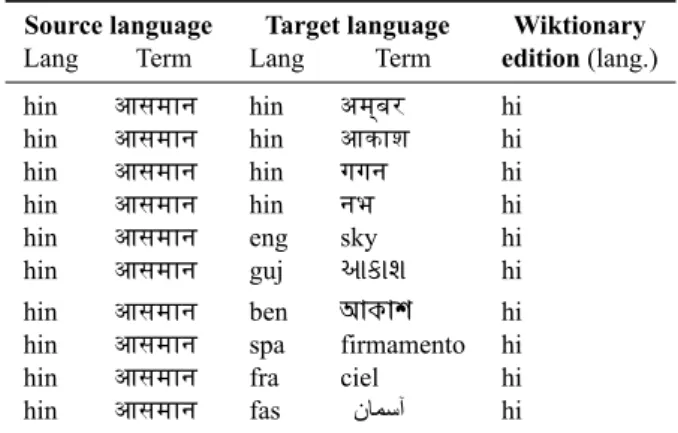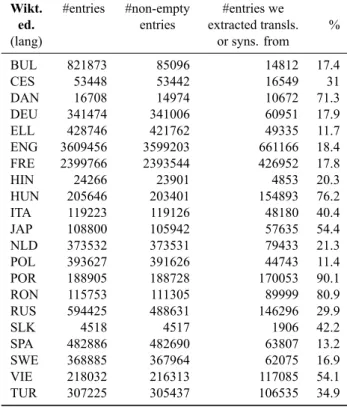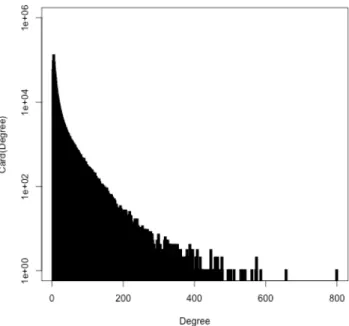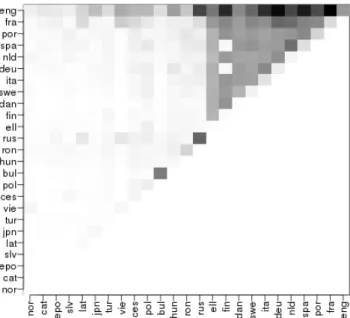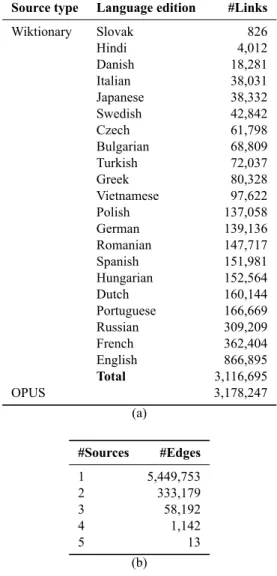HAL Id: hal-01022306
https://hal.inria.fr/hal-01022306
Submitted on 10 Jul 2014
HAL is a multi-disciplinary open access
archive for the deposit and dissemination of
sci-entific research documents, whether they are
pub-lished or not. The documents may come from
teaching and research institutions in France or
abroad, or from public or private research centers.
L’archive ouverte pluridisciplinaire HAL, est
destinée au dépôt et à la diffusion de documents
scientifiques de niveau recherche, publiés ou non,
émanant des établissements d’enseignement et de
recherche français ou étrangers, des laboratoires
publics ou privés.
YaMTG: An Open-Source Heavily Multilingual
Translation Graph Extracted from Wiktionaries and
Parallel Corpora
Valérie Hanoka, Benoît Sagot
To cite this version:
Valérie Hanoka, Benoît Sagot. YaMTG: An Open-Source Heavily Multilingual Translation Graph
Extracted from Wiktionaries and Parallel Corpora. Language Resources and Evaluation Conference,
European Language Resources Association, May 2014, Reykjavik, Iceland. �hal-01022306�
YaMTG: An Open-Source Heavily Multilingual Translation Graph
Extracted from Wiktionaries and Parallel Corpora
Valérie Hanoka
1,2Benoît Sagot
11. Alpage, INRIA Paris-Rocquencourt & Université Paris 7, bâtiment Olympe de Gouges, 75013 Paris, France 2. Verbatim Analysis, 14 rue Friant, 75014 Paris, France
valerie.hanoka@inria.fr, benoit.sagot@inria.fr
Abstract
This paper describes YaMTG (Yet another Multilingual Translation Graph), a new open-source heavily multilingual translation database (over 664 languages represented) built using several sources, namely various wiktionaries and the OPUS parallel corpora (Tiedemann, 2009). We detail the translation extraction process for 21 wiktionary language editions, and provide an evaluation of the translations contained in YaMTG.
Keywords: Translation Graph, Multilingual Lexicon, Wiktionary
1.
Introduction
Large-scale general-purpose multilingual translation databases are useful in a wide range of Natural Languages Processing (NLP) tasks. This is especially true for research efforts targeted to under-resourced languages. Translation databases can be used for adapting existing resources in other languages. This has been applied for example for the development of wordnets in languages other than English (see e.g., de Melo and Weikum (2009)).
There is thus a real need in NLP for open-source multilin-gual lexical databases that compile as many translations as can be found on any freely available resource in any lan-guage.
In this paper, we introduce YaMTG (Yet another
Multilin-gual Translation Graph), a new open-source heavily
mul-tilingual translation database (over 664 languages repre-sented). While developing YaMTG, we have put the em-phasis on the three following features:
1. Our resource is intended for general purpose;
2. We tried to to find a right balance between ‘large-scale’ and ‘quality’, thus leaving a limited amount of noise in the data;
3. No information is inferred from the data in order to avoid noise propagation.
4. The resource is easily accessible, usable and extensi-ble.
The remainder of this paper is organised as follows. We first overview the literature on related work (Section 2). Next, we describe in Section 3 how we extracted automatically a preliminary large-scale set of translation and synonym pairs from 21 wiktionary language editions and from the OPUS parallel corpora (Tiedemann, 2009). We detail the trans-lation extraction process for 21 wiktionary language edi-tions, and provide an evaluation of the extracted transla-tion and synonym pairs. Sectransla-tions 4 and 5 are then respec-tively dedicated to the construction of the translation and synonym graph proper and to its filtering, in order to re-duce the level of noise in the graph. Finaly, we provide in
Section 6 quantitative data about the final (filtered) graph YaMTG, together with an overall evaluation of YaMTG and an assessment of the quality of our filtering step.
2.
Related work
Research focused on the creation of heavily multilingual word-based translation databases tends to use collabora-tively constructed lexicons such as wiktionaries. By doing so, the community is taking advantage of the ‘the wisdom of crowds,’ thus overcoming the lack of expert-built lexicons for some languages (Meyer and Gurevych, 2012).
Etzioni et al. (2007) built TransGraph, a multilingual sense-distinguished dictionary extracted from wiktionaries and other dictionaries. It covers 100 languages, with 3 lan-guages having over 100,000 words. This translation graph was later reshaped by Mausam et al. (2009) with the cre-ation of the PanDictionary. It covers over 1000 languages, whose translations are still emanating from wiktionaries and other dictionaries. Yet, the resource doesn’t seem to be openly available as we write.
The PanLex project (Baldwin et al., 2010) is a lemmatic translation resource which combines a large number of mul-tilingual, bilingual, and monolingual lexical resources. It includes many inferred translations links, less accurate than directly extracted ones. As we write, it covers 1353 lan-guage varieties and 12M expressions extracted from more than 4000 different resources, including wiktionaries in many languages.1 It is still under development. The data is available on the PanLex website.2 To our knowledge, it is the most complete heavily multilingual translation database. However, we were not able to find an evaluation of the quality of the data.
Some researchers have produced multilingual translation data as a side effect of other goals. The success of the Princeton WordNet (Fellbaum, 1998) as a generic lan-guage resource spurred the creation of similar resources in other languages. Many researchers in non-English
speak-1http://panlex.org/tech/plrefs.shtml
(con-sulted in February 2014)
ing countries launched various projects, sometimes involv-ing several teams and languages, all aimed at creatinvolv-ing new wordnets in their respective languages (Hamp and Feldweg, 1997; Farreres et al., 1998; Pianta et al., 2002; Diab, 2004; Sagot and Fišer, 2008). A list of resources which follows the wordnet design can be found on the Global WordNet Association website.3 Researchers undertook several ac-tions to establish relaac-tionship between wordnets in differ-ent languages. The EuroWordNet project (Vossen, 1998) devolved the manual creation and linkage of new word-nets in 8 european languages upon several institutions over many years. Atserias et al. (2004) merged lexico-semantic information contained in local wordnets into the EuroWord-Net framework. Similar initiatives have been taken for the design and development of multilingual WordNets in oth-ers geographic areas, such as BalkaNet (6 languages, (Sta-mou et al., 2002)) or IndoNet (18 languages, (Bhat et al., 2013)). Their development was manually carried out by experts, event if some tasks were automated. Yet the qual-ity of the lexico-semantic information provided by these re-sources prevail over the multilingual aspect.
Half-way between large multilingual lexical databases and wordnet-like ontologies, some researchers aimed at uni-fying multilingual data from various sources into unique knowledge graphs.
De Melo and Weikum (2009) introduced, and further ex-tended (de Melo, 2012), their Universal WordNet, covering concepts in a language-independent fashion. To do so, they used wordnets in many languages, freely available transla-tion dictransla-tionaries, wiktransla-tionnaries in different language edi-tions, monolingual and multilingual thesauri and ontolo-gies, and parallel corpora (de Melo, 2012, p.35-37). The resulting resource covers over 200 languages, whose trans-lations were extracted from open-source dictionaries, wik-tionaries and parallel corpora. The '201012' dump down-loaded on February 2014 contains more than 85,000 mean-ings instantiated by nearly 1.5 million (1,481,412) lexical items. While lexemes in 419 languages are displayed, 46 languages have more than 10,000 instances. This Univer-sal Wordnet is freely available under a Creative Commons license.
Navigli and Ponzetto (2010, 2012) developed Babel-Net, a wide-coverage multilingual knowledge resource. They mapped encyclopedic and onto-lexical data (namely Wikipedia and Wordnet). Concepts thus obtained were sup-plemented with lexicalisations in a large number of lan-guages obtained via a machine translation pipeline. The latest version of BabelNet, namely BabelNet 2.0, contains 44,490,880 lexical items in 50 languages, regrouped under 9,348,287 synsets.
Among the resources mentioned above, the most interesting ones in terms of language coverage (Baldwin et al., 2010; de Melo and Weikum, 2009; Navigli and Ponzetto, 2012) make use of a specific translation graph architecture which links translations to meaning nodes rather than translations between them. This data structure tends to amplify noise in the translation data in case of a erroneous link between a term in a language and a meaning node.
3http://globalwordnet.org/?page_id=38
Compared to these works, YaMTG contains less lexical items (900,000 vs. 1.5M for UWN, 12M for PanLex and 44M for BabelNet 2.0; see Table 1 for details). This is be-cause it was designed using fewer sources, keeping its de-velopment cost low. We plan to include more translations to YaMTG in order to increase it's coverage soon. However, only PanLex covers more languages than YaMTG.
Multilingual Resource # Lexical Entries # Languages
YaMTG 881,643 664
UWN 1,481,412 419
PanLex 12,000,000 1353
BabelNet 2.0 44,490,880 50 Table 1: Comparison of the basic figures for the main mul-tilingual translation resources and YaMTG
3.
Translation Extraction
3.1. Wiktionaries 3.1.1. Extraction
As described by (Meyer and Gurevych, 2012), Wiktionary is a multilingual online dictionary encoding linguistic knowledge in multiple languages. There exists indepen-dent wiktionaries for each language. Those are called lan-guage editions. In each lanlan-guage edition, a wiki page cor-responds to a character string which can represent one or more lexical items. These items can either be in the tions' language, in other languages or both. Language edi-tions dumps are made available by the Wikimedia Foun-dation athttp://dumps.wikimedia.org/. We ex-tracted translations from the dumps4available in September 2013.
Wiktionaries are organised as a set of formatted pages, whose title may correspond to an article describing one or more lexical entries. The page content of the different lan-guage editions displays different structures for the linguis-tic information of the lexical entries. Sérasset (2012) plans to build and provide open-source access to an a language-independent automatic extractor for a comprehensive set of linguistic information encoded in different wiktionary lan-guage editions.
It is possible to custom a set of language specific triggers (Figure 1) for the identification and extraction of transla-tions and synonyms from wiktionary pages.
These triggers are instantiated by regular expressions. For instance, English edition triggers are:
• Translation_ON:{{trans-top.* • Translation_OFF:{{trans-bottom}} • Synonyms_ON:====Synonyms==== • Synonyms_OFF:{{checksyns}} • All_swiches_OFF:^\s*$ • Ignore:{{trans-[^tb].+}} 4
They can be downloaded directly at http:// dumps.wikimedia.org/*L*wiktionary/latest/ *L*wiktionary-latest-pages-articles.xml. bz2, replacing the ‘*L*’ part in the URL by the ISO-639-1 language code of the desired language edition.
Figure 1: Language independent set of triggers, switches and side effects for translation and synonymy extraction from wiktionaries.
• Source_Language:^[^>]*>?==([^=]+)==$ • Implicit_translations:^#\s*\[\[.+\]\].?$
For the Hindi edition, we instantiated the triggers as follows: • Translation_ON: ^\({{-trans-}}\)|\( *==* * अन्य भाषाओं में *==*\)|\( *==* * अनुवाद *==*\) • Translation_OFF: ^\( *{{-.*\)|\( *==\)|\(^\[\[\) • Synonyms_ON: ^ *==* * समानार्थी! *==* • Synonyms_OFF: ^\[\[.* • All_swiches_OFF: ^= • Ignore: • Source_Language: space="preserve">{?{?-?(.[^-]*)-?}?}? • Implicit_translations: ^ *#\s*\(([^)]*)\)\s*\[\[.*
Using this customized triggers for every article page in a wiktionary edition enable the extraction of raw translation data. Figure 2 shows an example of raw data extracted from the Hindi edition with the set of Hindi triggers presented above.
Noisy elements (e.g., punctuation characters) are then re-moved. Languages names (e.g., हिन्दी5) and language codes (e.g., ‘en’ for English, ‘gu’ for Gujarati) are converted in ISO 639-2 (alpha-3) language codes.6 The information is put in a normalised format (Table 2), keeping track of the origin of the translation at the end of each line (e.g., #WY_hi stands for Hindi wiktionary; see Table 2).
5हिन्दी is the Hindi term for ‘Hindi.’ 6
List available athttp://www.loc.gov/standards/ iso639-2/php/code_list.php #ITEM# आसमान #LANG# == हिन्दी == #IT# # [[ अम्बर ]] #IT# # [[ आकाश ]] #IT# # [[ गगन ]] #IT# # [[ नभ ]] #TRANS#
* {{en}} : [[sky]] [[:en:sky]] * {{gu}} : [[ આકાશ ]] [[:gu: આકાશ ]] * {{bn}} : [[ আকাশ ]] [[:bn: আকাশ ]] * {{es}} : [[firmamento]] [[:es:firmamento]] * {{fr}} : [[ciel]] [[:fr:ciel]]
* {{fa}} : [[ نﺎﻤﺳآ ]] [[:fa: نﺎﻤﺳآ ]]
Figure 2: Fragment of the raw extraction of translation for the Hindi wiktionary.
Source language Target language Wiktionary
Lang Term Lang Term edition (lang.)
hin आसमान hin अम्बर hi hin आसमान hin आकाश hi hin आसमान hin गगन hi hin आसमान hin नभ hi hin आसमान eng sky hi hin आसमान guj આકાશ hi hin आसमान ben আকাশ hi hin आसमान spa firmamento hi hin आसमान fra ciel hi hin आसमान fas نﺎﻤﺳآ hi
Table 2: Fragment of the normalized translation extracted from the Hindi wiktionary.
3.1.2. Evaluation of the extraction process
Table 3 presents the proportion of wikipedia entries from which translations or synonyms have been extracted for 21 languages edition, together with the number of raw (unfil-tered) translation pairs extracted.
The biggest wiktionary editions (English and French) have an extraction for roughly a quarter of their non-empty en-tries (respectively 18.4% and 17.8%). The best extraction rates (90.1% and 80.9%) have been achieved for the Por-tugese and Romanian editions. Greek and Polish are the two edition having worst extraction rates (11.7% and 11.4%). For Greek, that poor score seem to be mainly due to implicit translations which are not extracted from articles in another language. More precisely, we retain only one trigger for im-plicit translations (^#\s*\[\[.+\]\].?$). Yet many implicit translations are marked by the pattern^* \[\[. We chose not to identify this trigger because, as it is also used to mark related terms (συγγενικά). Therefore, it would bring much noise in the data.
We evaluated the wiktionary extraction process for the 21 languages edition we processed by randomly selecting 3150 translation pairs (150 extracted from each language edition) and manually checking their adequacy against the corre-sponding wiktionary.
Table 4 presents the result of this evaluation with an er-ror analysis. Accuracy scores range from 78% (Spanish) to 97.3% (Dutch). We identified 4 major error classes:
1. translations whose source or target language hasn’t been successfully identified;
Wikt. #entries #non-empty #entries we
ed. entries extracted transls. %
(lang) or syns. from
BUL 821873 85096 14812 17.4 CES 53448 53442 16549 31 DAN 16708 14974 10672 71.3 DEU 341474 341006 60951 17.9 ELL 428746 421762 49335 11.7 ENG 3609456 3599203 661166 18.4 FRE 2399766 2393544 426952 17.8 HIN 24266 23901 4853 20.3 HUN 205646 203401 154893 76.2 ITA 119223 119126 48180 40.4 JAP 108800 105942 57635 54.4 NLD 373532 373531 79433 21.3 POL 393627 391626 44743 11.4 POR 188905 188728 170053 90.1 RON 115753 111305 89999 80.9 RUS 594425 488631 146296 29.9 SLK 4518 4517 1906 42.2 SPA 482886 482690 63807 13.2 SWE 368885 367964 62075 16.9 VIE 218032 216313 117085 54.1 TUR 307225 305437 106535 34.9 Table 3: Proportion of wiktionary entries having at least one raw translation and/or synonym pair extracted by our system.
3. translation containing residual ‘noise’ (mainly non al-phanumeric characters);
4. miscellaneous errors.
Most instances of class 1 to 3 errors will be discarded by the filtering step described in Section 5. Type 4 (‘miscel-laneous’) errors are the most detrimental, as most of them will remain in the data.
Table 4 indicates a mean score of 87.6% for the unfiltered extraction. However, this score is biased because small-est languages edition are overrepresented. Weighting the scores by the size of the extraction (Table 3) leads to a more reliable score of 89.4%.
3.2. Opus
OPUS (Tiedemann, 2009) is a collection of translated texts from the web aimed at providing the community with a publicly available parallel corpus in a wide variety of lan-guages. We used the word alignments issued on October 9, 2013 to add new translations links in the graph, retain-ing only alignments with a frequency at least 10. With this threshold, we retained 576131 terms (or lexical items) for 3598227 translations in 31 languages from OPUS transla-tions. As OPUS translations are prone to alignment errors, their quality may not be as good as desired. Yet they con-tains a substantial amount of inflected forms which are not necessarily present in other sources. We rely on the filtering steps (Section 5) to avoid retaining the worst translations.
4.
Building the Translation Graph
Previous steps resulted in more than 18M translations or synonyms in 4,324 languages.7Note that while wiktionary translations are mainly lemmas, OPUS translations consists in a lot of inflected terms’ trans-lations. We kept them in the graph, but it is easy to get rid of them as we kept translations origins in the data. Dis-carding translations originating from OPUS only thus re-moves inflected terms. All these translations contains a lot of noise such as errors identified in Section 3.1.2 plus align-ment flaws arising in OPUS data.
5.
Filtering
Unfiltered translations gathered in previous steps need to be filtered in order to decrease the noise. We removed many translations matching one of the following criteria:
• They are ‘too long’ (usually Section’s 3.1.2 class 3 er-rors, i.e., definitions mistaken for translations) or ‘too short’8(usually stopwords);
• They contain punctuations and/or numbers;
• Their charset does not correspond to their declared lan-guage;
• They appear in less than X other translations; • They appear in more than Y other translations (when
too many translations are available for the same word, it turns out it is very often the result of an error). The first three filtering criteria are designed to avoid er-rors from class 1 to 3 as identified in Section 3.1.2 The two last criteria were rather designed to get rid of types 4 errors (miscellaneous errors) and OPUS misalignment. We em-pirically chose X = 3. Concerning Y , we assumed that it may be somehow related to the number of languages present in the graph. After applying the first filtering criteria, the graph displays terms (lexical items) in 3,739 languages. For those languages, only 468 appears 100 times or more. We assumed that a term should reasonably not have more than an average of 2 translations for all of these 468 languages. In other words, we decided that a term should not be in-volved in more than Y = 936 translations.
6.
Results and evaluation
6.1. Graph properties
The filtered graph retains nearly a tenth of the terms and 15% of the languages present in the unfiltered graph. Yet, 32.3% of the translation/synonym links, or edges, are re-tained (cf. Table 6). 51.2% of these remaining translations are extracted solely from OPUS, 42,1% from wiktionaries only, whereas 3.2% were extracted from both OPUS and at least one of the 21 wiktionaries we processed.
7As a standard of comparison, the Ethnologue association
states living languages number more than 7,105 (http://www. ethnologue.com/).
8
This filter does only concern less than 3 letters words written in Cyrillic, Greek and Latin script.
Before Filtering After Filtering
Lang. Erroneous Good Erroneous Good Kept
edition Misc. lang. def. noise raw % Misc. lang. def. noise raw % %
bg 8 1 1 4 136 90.7 3 0 1 0 93 95.9 64.7 cs 4 0 19 5 122 81.3 0 0 2 1 16 84.2 12.7 da 2 0 3 2 143 95.3 1 0 0 0 65 98.5 44 de 4 1 0 2 143 95.3 1 0 0 0 46 97.9 31.3 el 4 0 5 2 139 92.7 1 0 2 1 65 94.2 46 en 1 5 0 4 140 93.3 1 1 0 0 111 97.4 76 es 5 0 15 13 117 78 0 0 0 1 46 97.9 31.3 fr 4 0 8 0 138 92 2 0 3 0 95 95 66.7 hi 9 3 3 4 131 87.3 1 0 0 0 42 97.7 28.7 hu 3 9 1 1 136 90.7 1 2 0 0 56 91.8 40.7 it 0 4 14 2 130 86.7 0 1 0 0 58 96.7 40 ja 2 10 26 15 97 64.7 1 3 8 0 38 71.7 35.3 nl 0 0 0 4 146 97.3 0 0 0 0 68 100 45.3 pl 3 3 0 2 142 94.7 0 0 0 0 68 100 45.3 pt 5 3 18 4 120 80 2 0 0 0 89 97.8 60.7 ro 0 0 13 3 134 89.3 0 0 0 0 116 100 77.3 ru 10 1 4 2 133 88.7 1 0 0 0 95 99 64 sk 5 7 12 0 126 84 2 0 0 0 39 95.1 27.3 sv 4 4 9 0 133 88.7 2 3 0 0 69 89.6 51.3 tr 2 11 4 0 133 88.7 0 1 1 0 83 96.5 57.3 vi 9 0 20 0 121 80.7 0 0 0 0 31 100 20.7 Total 84 62 175 69 2760 — 19 11 17 3 1389 — — % 2.7 1.9 5.6 2.2 87.6 — 1.3 0.8 1.2 0.2 96.5 — —
Table 4: Evaluation figures for the unfiltered extraction of translations/synonymy from 21 wiktionary editions (sample size for each language: 150), and for the filtered graph.
Wiktionaries OPUS Union
Terms 5,246,987 487,251 7,903,646 Transl./Syn. links 14,449,087 3,631,229 18,080,316
Languages 4,324 32 4,324
Table 5: Number of unfiltered translations and synonyms links in wiktionaries and OPUS and the union of both
Before filtering After Filtering (YaMTG)
Terms 7,903,646 881,643
Transl./Syn. 18,080,316 5,842,279
Languages 4,324 664
Table 6: Number of terms, translations and synonyms be-fore and after applying filters.
Figure 3 displays the degree distribution in the graph. This distribution resembles that of a small-world graph, a type of graph often encountered when modeling real-world data. Small-world graphs have tightly interconnected node clus-ters, and a shortest mean path length that is similar to that of a random graph that has the same number of nodes and the same number of edges. We checked the ‘small-world-ness’ of our translation graph against the definition of that notion as presented by Humphries and Gurney (2008).9 It turns out
9Humphries and Gurney (2008) define a graph G as being
small-world by constrast with an Erdős-Rényi random graph Grand
that has the same number of nodes and edges than G in the fol-lowing way. Let us call LG(resp. LGrand) the average shortest
Figure 3: Degree distribution in the filtered graph YaMTG.
that our translation graph indeed qualifies as a small-world graph.
Figure 4 illustrates the distribution of translation or syn-onymy pairs w.r.t. the languages at both ends of the pair. path length in G (resp. Grand). Moreover, let n∆Gthe number of
triangles in G and n(2)Gthe number of paths of length 2 in G.
We then define the transitivity-based clustering coefficient in G as
C∆
Source total Erroneous Good
Misc. lang. def. noise
OPUS 99 10 0 0 0 89 90%
Wiktionaries 85 2 4 0 2 77 91%10
Both 16 0 0 0 0 16 100%
Total 200 12 4 0 2 182 91%
Table 7: Evaluation figures for the final (filtered) translation/synonymy graph, i.e., YaMGT based on a randomly selected sample of 200 edges.
Figure 4: Language matrix for the 25 most frequent lan-guages in the graph (darker means more translation or syn-onymy pairs).
We evaluated the quality of the final graph by looking over 1,639 edges selected as follows:
• 1,439 edges which were evaluated in Section 3.1.2 and still present in the final graph. This will allow us to evaluate the reliability of the filtering described in Sec-tion 5;
• 200 more edges randomly chosen in the translation graph, in order to assess its overall accuracy in a non biaised way.
These edges cover 3,332 terms in 72 languages.
6.2. Overall evaluation
We estimated the overall accuracy of the links in the filtered graph based on a manual evaluation of the 200 randomly selected pairs. The overall accuracy result is 91% (see Ta-ble 7). Amongst the 18 incorrect links in this random evalu-ation dataset (9%), 4 are incorrect because one of the terms is a small-world graph whenever LG≥ LGrandand C
∆
G≫ CG∆rand.
10This figure is lower than one would expect given the results
displayed in Figure 4. This is an artifact related to the low number of pairs randomly selected for evaluation, resulting in a even lower number of errors among pairs extracted from wiktionaries only (8 errors). As we shall see below, the accuracy of translation pair extracted from wiktionaries is closer to 97%.
have been assigned a wrong language, 2 still contain noise and 13 are miscellaneous errors (mostly alignment errors from OPUS). Note that all wikipedia definitions mistaken for translations were successfully removed by the filter.
6.3. Filter’s accuracy
Amongst the 3,150 translation links evaluated in Sec-tion 3.1.2, 1,439 (45.3%) were still present in the final graph. Table 4, restricted to links extracted from wiktionar-ies, compares the figures before and after filtering. It dis-plays an average accuracy score of 95.8% for the filtered ex-traction. Weighting the scores by the proportion of transla-tions/synonyms from the different language editions present in the final graph (Table 8) gives us a final accuracy score of 97.2% for translations extracted from wiktionaries. On average, the filter managed to improve accuracy scores by nearly 8 points the (raw and weighted).
7.
Conclusions
YaMTG is an Open-Source Heavily Multilingual Transla-tion Graph, freely available online.11 Its aim is mainly to provide a ready-to-use translation graph. Further versions including other translation sources are under development and will be released soon. The version of YaMTG pre-sented in this paper contains 5.8 million translation or syn-onymy pairs (edges in the graph) covering 664 languages. Those translations were extracted from 21 wiktionary lan-guage editions and from the OPUS Parallel Corpora, and then filtered using generic and graph-based heuristics. We evaluated the quality of the initial set of translations ex-tracted from our various source, the precision of our filter-ing step and the accuracy of its output, namely YaMTG. We estimated overall quality of the translation/synonymy links within YaMTG as approximatively 91%. If one only considers translation/synonymy links extracted from wik-tionaries, this figure reach as much as 97.2%.
In the future, these scores could be improved with a two-fold strategy:
• Adding new translations to the unfiltered graph. The filtering step removes lexical items which are not present in at least X other translations. Thus, satisfy-ing translations which tend to occur less in translation databases are more likely to be removed by the filter. More pairs in the unfiltered graph should lead to less overfiltering.
11http://alpage.inria.fr/~hanoka/yamgt.
Source type Language edition #Links Wiktionary Slovak 826 Hindi 4,012 Danish 18,281 Italian 38,031 Japanese 38,332 Swedish 42,842 Czech 61,798 Bulgarian 68,809 Turkish 72,037 Greek 80,328 Vietnamese 97,622 Polish 137,058 German 139,136 Romanian 147,717 Spanish 151,981 Hungarian 152,564 Dutch 160,144 Portuguese 166,669 Russian 309,209 French 362,404 English 866,895 Total 3,116,695 OPUS 3,178,247 (a) #Sources #Edges 1 5,449,753 2 333,179 3 58,192 4 1,142 5 13 (b)
Table 8: Number of translations and synonyms by number of distinct sources it was extracted from (subtable a). Note that a same translation link (or edge) may have been ex-tracted from more than one sources (e.g., wiktionary lan-guage editions) and can be therefore counted more than once (see subtable b).
• Similarly, playing with the thresholds X and Y (see section 5) may improve the quality of the graph. But increasing X requires to have a sufficient amount of translations.
8.
References
Atserias, J., Villarejo, L., Rigau, G., Agirre, E., Carroll, J., Magnini, B., and Vossen, P. (2004). The meaning multi-lingual central repository. In In Proceedings of the
Sec-ond International WordNet Conference, pages 80--210.
Baldwin, Timothy, Pool, Jonathan, and Colowick, Susan M. (2010). Panlex and lextract: Translating all words of all languages of the world. In COLING 2010, 23rd
In-ternational Conference on Computational Linguistics, Demonstrations Volume, 23-27 August 2010, Beijing, China, pages 37--40.
Bhat, Brijesh, Poddar, Lahari, and Bhattacharyya, Push-pak. (2013). IndoNet: A Multilingual Lexical Knowl-edge Network for Indian Languages. In in Proceedings
of the Annual Meeting of the Association for Computa-tional Linguistics (ACL), Sofia, Bulgaria.
de Melo, Gerard and Weikum, Gerhard. (2009). Towards a universal wordnet by learning from combined evidence. In Proceedings of the 18th ACM conference on
Informa-tion and knowledge management, CIKM '09. ACM.
de Melo, Gerard. (2012). Graph-based Methods for
LargeScale Multilingual Knowledge Integration. universaar
-Saarland University Press, Saarbrücken, Germany. Diab, Mona T. (2004). The feasibility of bootstrapping an
arabic wordnet leveraging parallel corpora and and an en-glish wordnet. In Proceedings of the Arabic Language
Technologies and Resources, Cairo.
Etzioni, Oren, Reiter, Kobi, Soderland, Stephen, and Sam-mer, Marcus. (2007). Lexical translation with applica-tion to image search on the web.
Farreres, Xavier, Rigau, German, and Rodríguez, Horacio. (1998). Using wordnet for building wordnets.
Comput-ing Research Repository, cmp-lg/980.
Fellbaum, Christiane, editor. (1998). WordNet: An
Elec-tronic Lexical Database. MIT Press, Cambridge,
Mas-sachusetts.
Hamp, Birgit and Feldweg, Helmut. (1997). Germanet -a lexic-al-sem-antic net for germ-an. In In Proceedings
of ACL workshop Automatic Information Extraction and Building of Lexical Semantic Resources for NLP Appli-cations, pages 9--15.
Humphries, Mark D and Gurney, Kevin. (2008). Net-work `small-world-ness': a quantitative method for de-termining canonical network equivalence. PLoS One, 3(4):e0002051.
Mausam, Soderland, Stephen, Etzioni, Oren, Weld, Daniel S., Skinner, Michael, and Bilmes, Jeff. (2009). Compiling a massive, multilingual dictionary via prob-abilistic inference. In Proceedings of the 47th Annual
Meeting of the ACL and the 4th International Conference on NLP of the AFNLP, ACL '09, pages 262--270, Suntec,
Singapore.
Meyer, Christian M. and Gurevych, Iryna. (2012). Wik-tionary: a new rival for expert-built lexicons? explor-ing the possibilities of collaborative lexicography. In Granger, Sylviane and Paquot, Magali, editors,
Elec-tronic Lexicography, chapter 13, pages 259--291.
Ox-ford: Oxford University Press, November.
Navigli, Roberto and Ponzetto, Simone Paolo. (2010). Ba-belNet: Building a Very Large Multilingual Semantic Network. In Proceedings of the 48th Annual Meeting
of the Association for Computational Linguistics, pages
216--225, Uppsala, Sweden.
Navigli, Roberto and Ponzetto, Simone Paolo. (2012). Ba-belNet: The automatic construction, evaluation and ap-plication of a wide-coverage multilingual semantic net-work. Artificial Intelligence, 193:217--250.
Pianta, Emanuele, Bentivogli, Luisa, and Girardi, Christian. (2002). Multiwordnet: developing an aligned multilin-gual database. In Proceedings of the First International
Conference on Global WordNet.
french wordnet from multilingual resources. In Ontolex
2008, Marrakech, Morocco.
Sérasset, Gilles. (2012). Dbnary: Wiktionary as a lmf based multilingual rdf network. In Chair), Nico-letta Calzolari (Conference, Choukri, Khalid, Declerck, Thierry, Doğan, Mehmet Uğur, Maegaard, Bente, Mar-iani, Joseph, Odijk, Jan, and Piperidis, Stelios, editors,
Proceedings of the Eight International Conference on Language Resources and Evaluation (LREC'12),
Istan-bul, Turkey, may. European Language Resources Asso-ciation (ELRA).
Stamou, Sofia, Oflazer, Kemal, Pala, Karel, Chris-toudoulakis, Dimitris, Cristea, Dan, Tufis, Dan, Koeva, Svetla, Totkov, George, Dutoit, Dominique, and Grigo-riadou, Maria. (2002). Balkanet a multilingual seman-tic network for the balkan languages. Proceedings of the
International Wordnet Conference, Mysore, India, pages
21--25.
Tiedemann, Jörg. (2009). News from OPUS - A Collec-tion of Multilingual Parallel Corpora with Tools and In-terfaces. In Nicolov, N., Bontcheva, K., Angelova, G., and Mitkov, R., editors, Recent Advances in Natural
Lan-guage Processing (vol V), pages 237--248. John
Ben-jamins, Amsterdam/Philadelphia.
Vossen, Piek, editor. (1998). EuroWordNet: a multilingual
database with lexical semantic networks. Kluwer

